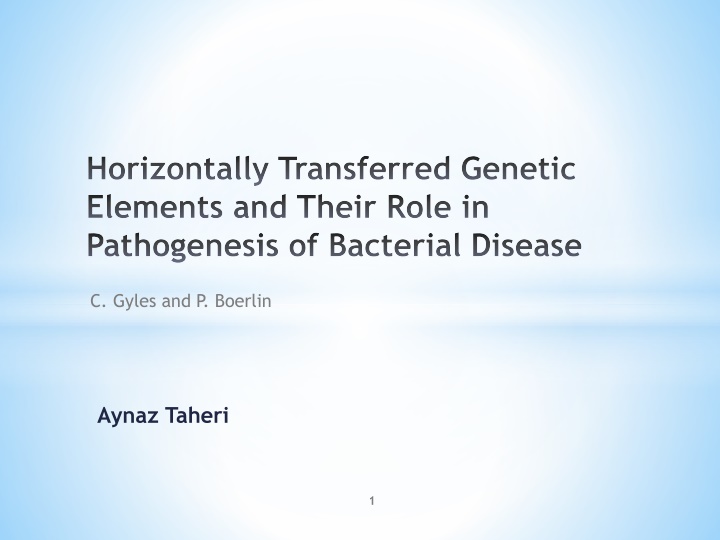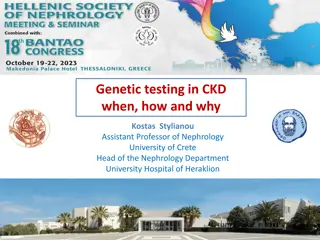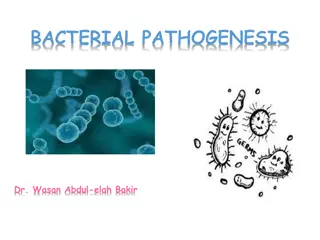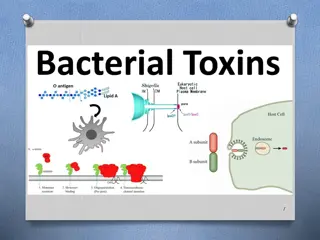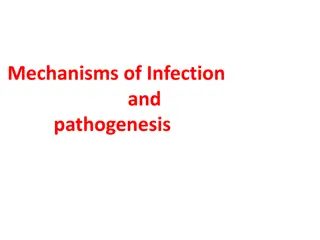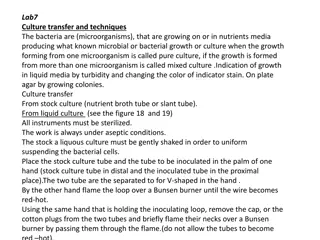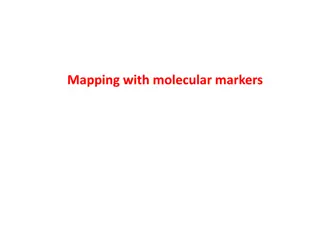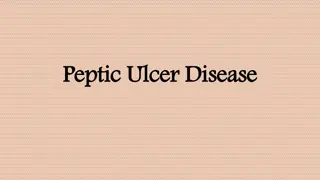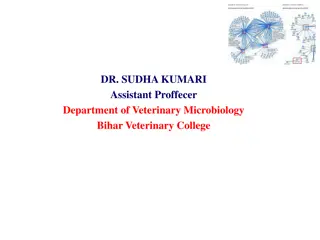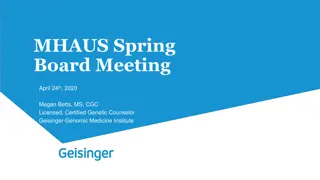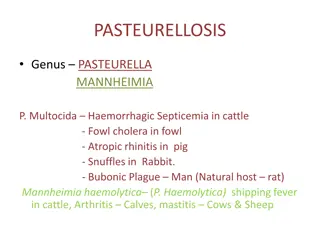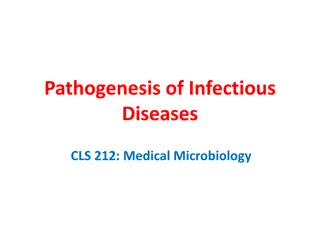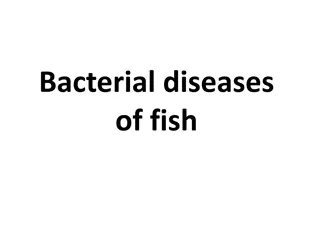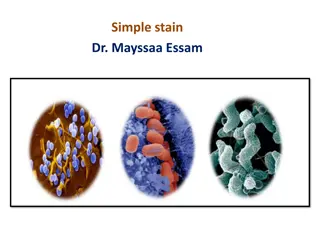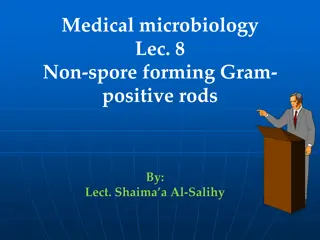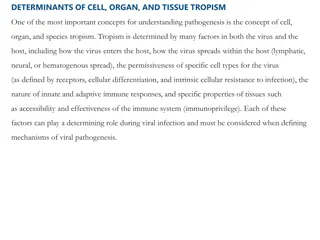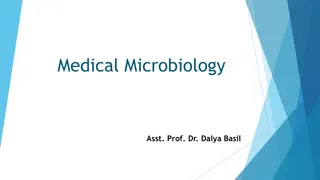Mechanisms and Role of Horizontally Transferred Genetic Elements in Bacterial Disease Pathogenesis
This presentation explores the transfer of foreign DNA into bacteria, discussing mechanisms such as conjugation, transduction, and transformation. It delves into the significance of Mobile Genetic Elements (MGEs) like plasmids, bacteriophages, and transposons in bacterial virulence and pathogenesis. The content highlights the role of MGEs in facilitating the movement of genetic material between bacterial species, aiding in the spread of pathogenic traits. Special focus is placed on insertion sequences, transposons, and their impact on bacterial genetics and evolution.
Download Presentation

Please find below an Image/Link to download the presentation.
The content on the website is provided AS IS for your information and personal use only. It may not be sold, licensed, or shared on other websites without obtaining consent from the author.If you encounter any issues during the download, it is possible that the publisher has removed the file from their server.
You are allowed to download the files provided on this website for personal or commercial use, subject to the condition that they are used lawfully. All files are the property of their respective owners.
The content on the website is provided AS IS for your information and personal use only. It may not be sold, licensed, or shared on other websites without obtaining consent from the author.
E N D
Presentation Transcript
Horizontally Transferred Genetic Elements and Their Role in Pathogenesis of Bacterial Disease C. Gyles and P. Boerlin Aynaz Taheri 1
Outline *Transfer of foreign DNA *Mechanisms of transfer of DNA *Mobile genetic elements (MGE) *MGEs in the virulence of 4 major pathogens *Conclusion 2
Transfer of DNA *Foreign DNA originated from another organism and inserted to a bacterium. * Characteristics: Different G+C percentage Codon usage Regions that are adjacent with the foreign DNA *Horizontal or Lateral Gene Transfer (LGT) *Mobile Genetic Element (MGE) *Mechanisms of transfer of DNA 3
1. Conjugation Direct cell-to-cell contact 4
2. Transduction DNA transferred by a virus 5
3. Transformation Direct uptake of naked DNA 2 2 2 6
MGEs Elements Plasmid Bacteriophage Integrative and conjugative elements (ICE) Pathogenicity island (PAI) Mechanism of Transfer Conjugation Transduction Conjugation Transduction, Conjugation, Transformation Transformation Insertion Sequences , Transposon 7
Insertion Sequence (IS) *Small segment of DNA *Encode gene for mobilization and insertion. *Simplest type of transposable elements found in bacteria. *Two characteristics: 700 to 2500 bp, code proteins in transposition 8
Transposon *Barbara McClintock s discovery of these jumping genes earned her a Nobel prize in1983 *Transposons carry other genes in addition to transposition function *Intrabacterial movement of DNA *They may be transferred to other bacteria by transfer of plasmid or chromosomal DNA Cut and paste Copy and paste Interrupted DNA sequence Interrupted DNA sequence Target site Target site Transposon Transposon 9
Plasmid *Small DNA molecule within a cell that is physically separated from a chromosomal DNA *Plasmids can perform conjugation *Plasmids carry such as genes drug resistance, virulence factors, and fitness *Plasmid encoded many bacterial toxins: Bacillus Anthracis: pathogen of anthrax (PXO1) Yersinia Pestis: pathogen of plague 10
Bacteriophage * Bacterial viruses that invade bacterial cells * Composed of proteins that encapsulate a DNA or RNA genome * Phages replicate within the bacterium following the injection of their genome into its cytoplasm * Bacterial toxins in the genomes of phages: Corynebacterium diphteriae Botulism: botulinum toxin CTX: cholera toxin 11
Pathogenicity Island (PAI) *Genomic islands (GEIs) are large segments (10-200 kb) of foreign DNA *GEIs are usually flanked by IS and are inserted close to tRNA *GEIs that carry virulence genes are called PAIs *Mobilization for PAIs: conjugation, transduction and transformation 12
Integrative and Conjugative element (ICE) *Mobile genetic elements that reside in the host cell s chromosome *Mobilization: conjugation *Transfer large amount of genetic materials *Common features with transposons, bacteriophages and plasmids: Integrative ability of bacteriophages or transposons Transfer mechanisms of conjugative plasmids 13
Virulence of Four Pathogens *Roles of horizontallytransferred genes in virulence of bacterial pathogens: E. coli Salmonella Pyogenic Sterptococci Clostridium perfringens and Necrotic Entries 14
E. Coli *Escherichia coli is a rod-shaped bacterium of the genus Escherichia. *Core of important genes + accessory genome *Core DNA: ratio of G+C 50.8%, 1700 genes *Genome size from 4.6 to 5.6 Mb *Complexity of gene organization by Insertions, deletions and rearrangement over time. Nonpathogenic E. Coli Pathogenic Encodes more than 1600 proteins that are not found in nonpathogenic Plasmids, phages and PAIs transferred to nonpathogenic Enterotoxigenic E. Coli: diarrhea 15
Salmonella *A genus of rod-shaped bacteria of the enterobacteriaceae family. Salmonella bongori, Salmonella enterica *A pathogen that can invade intestinal cells and causes different enteric and systemic diseases . * E. Coli and Salmonella have the same ancestor. * Accessory genome consisting of PAIs, bacteriophages, and plasmids. *21 PAIs in Salmonella, called Pathogenicity Islands Salmonella (PIS) *PIS-1 and PIS-2: Invasion in nonphagocytic cells and replication in phagocytic and nonphagocytic cells. 16
Pyogenic Streptococci *An important group of human and animal pathogens *Role of MGEs in the virulence and host adaptation *Streptococcus pyogenes: human specific pathogen Local pyogenic infections, septicemia, toxic shock syndrome, necrotizing fasciitis and postinfection rheumatic fever 113 genes acquired by S. pyogenes through LGT are located in prophages, including 5 virulence genes. *Streptococcus agalactiae: main hosts are cattle and humans Important LGT between S. agalactiae and S. pyogenes ICEs in S. agalactiae containing virulence genes and adaptation genes in cattle *Streptococcus canis, streptococcus equi 17
Pyogenic Streptococci *Streptococcus canis: was first isolated in dogs An important pathogen of dogs and also other animal species, including cattle Presence of multiple MGEs in S. canis involving virulence genes Phages, ICE and plasmid 18
Clostridium perfringens and Necrotic Enteritis *A rod-shaped bacterium of the genus Clostridium. C. Can be found as a normal component of decaying vegetation, marine sediment, the intestinal tract of humans and other vertebrates, insects, and soil. Plasmids have a critical role in diseases: tetanus toxin, enterotoxin, cytotoxin, NetB toxin *Necrotic Enterities: hosted by poultry *Necrotic enteritis has been identified in broilers, laying hens, turkeys and quail Caused by toxins produced by C. perfringens MGEs have important role on this economically important disease 19
Conclusion *Understanding of bacterial adaptability, pathogenesis, and evolution *Conduct genome searches for foreign genes that affect adaptation to the animal or human environment *Recognize likely developments in the years ahead *Find activities that accelerate the emergence of new virulent pathogens continuously created through LGT *Reduce the capability for treating the disease they cause 20
